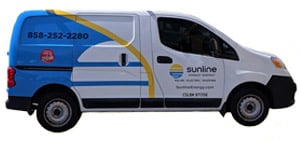Never be without power again – even during a grid failure.
This is another in a long list of “marketing promises” that solar installers make during their sales pitches. And it’s not hard to understand the allure – especially in a state with such a rich history of blackouts and brownouts.
But is this really true? Does a standard San Diego solar installation really protect you from power outages?
The answer is both “yes” and “no.”
Let’s explore.
What to Expect from Your San Diego Solar Installation
There are a few different ways to configure your solar installation – each with slightly different pros and cons.
1. Off-grid with Battery Storage
Some San Diego residents choose to opt out of the utility game completely. They purchase large enough solar installations to cover all of their daytime electricity needs. But they also buy solar batteries to provide continuous power even when the sun goes down.
The good news is that grid failures (i.e. blackouts) never affect you. The bad news, however, is that solar batteries are crazy expensive (although this is changing). Moreover, you miss out on all the great benefits of net metering. For a more exhaustive discussion, read our earlier post on this topic.
2. Grid-tied with a Standard Inverter
Solar photovoltaic (PV) systems sold throughout California are legally required to have a safety mechanism that powers down the installation during a blackout.
The reason behind this feature?
Utility repair crews run the risk of electrocution from wires that are still receiving current from active solar panels. And thus, PV systems are required to turn off automatically if the entire grid goes down.
What this means is that San Diego solar installations that use standard inverters don’t shield you from blackouts. Your system will power off, and you’ll be without electricity just like everyone else.
3. Grid-tied with Hybrid Inverter
Many San Diego homeowners and businesses equip their installations with hybrid inverters that are able to redirect solar electricity back into the home for local use – in the event of a grid malfunction.
SMA, for example, has a special inverter that can deliver up to 1500 W of continuous daytime electricity – enough to charge your routers, computers, and smart phones.
But note that this is only for daytime use. To be fully protected, you’d still need to purchase onsite battery storage for nighttime power. Otherwise, you’ll be in the dark just like everyone else.
This, of course, increases your solar installation cost and extends your payback period.
So Is Your San Diego Solar Worth the Added Expense?
100% energy independence and total protection from blackouts.
It’s doable. But is it practical? Is that 1% chance of a grid failure truly worth the added expense of costly batteries that need replacing every 5 to 10 years?
Ultimately, it’s up to you.
Maybe your energy requirements demand 24/7, uninterrupted power – no matter what (i.e. hospitals, military installations, data centers). But for the average homeowner or business, this level of energy security usually isn’t necessary.

